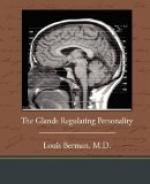The sex conflict has been the cause for the origin and the survival of certain physical and mental traits, helpful in sex attraction, sex combat, the growth of the embryo, and the nutrition and safety of the young of a species,—in short, the whole process of sexual selection. The proportions of the skeleton, the distribution of hair and fat, the construction of organs of attack and defense, the color of the skin, the cyclic processes of preparation for impregnation, the oestrus or heat period in animals, the menstrual period in the human being, the psychic reactions to danger and combat have all been thus determined. That man is bearded while woman is not,—that woman has potentially functional breasts while man has not,—the aggressive pugnacity of man contrasted with the more passive timidity of woman, have all been evolved in the sex struggle, surviving because most effective in that struggle. These so-called secondary sexual characteristics are an expression of the influence of the internal secretion of the gonads, or the interstitial glands. Some call them puberty glands, because their ripening initiates puberty.
We know that these interstitial glands, to stick to that name, (rather than to the name of the puberty glands, since they serve not only to induce puberty but to maintain maturity) are the actual primary dictators of the process by which male and female are distinguished, if not created. Castration was probably the first surgical operation carried out for experimental purposes, suggested no doubt by a curiosity concerning its effects. Trepanning of the skull, the geologic record indicates, was done even by the cave man. But as an experimental operation, castration seems to hold the primary position in the annals of surgery.
Its effects noted, the satisfaction of one of the lower human instincts, jealousy, popularised it. From the days of Semiramis, eunuchs have been commonplace figures of the East, their function definite: to guard the harems of the powerful. The age of Abdul Hamid witnessed no diminution of the barbaric tortures by which children are prepared for the profession. It is to the credit of England that in its dominions in the Orient the practice has been abolished. But it goes on even today. According to the best authorities, four out of five of these victims at the auto-da-fe of a vicious human instinct die immediately or soon after from exhaustion due to pain and infection. Not all of the ancient nations countenanced the brutal horror. The Hebrews placarded castration an unpardonable sin, making it a sin to castrate even animals. Nor was any man so mutilated permitted to worship in the house of the Lord (Deuteronomy xxiii, 11). Yet we have evidence that the latter Jewish kings employed foreign eunuchs in their harems, who often held the most important positions as ministers of the court.
Besides the eunuchs, another group of people have presented material for the study of the interstitial glands. These are the Skoptzi of Russia and the Lipowaner of Roumania. Among them castration is a religious ritual. Mankind has always been most brutal to itself in the name of the ideal. These sects were founded because in the eighteenth century an antipode of Joseph Smith and Brigham Young discovered this passage in Matthew xix, 12.




